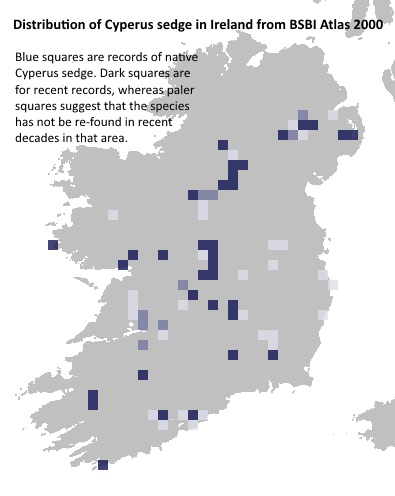Status
Native status
Native species
Species Biology
Identification
- Cyperus sedge plants grow in loose tufts or clumps and are yellowish green in colour.
- The tall leaves have a sheath which completely surrounds the stem until the leaf blade grows away from the stem. These feel rough on the keel (the underside where the two sides of the leaf blade meet) and at their edges.
- Plants flower in June.
- The flowering stem is 40-90cm tall and is three sided (triangular) in section like many species in the Carex genus.
- The stem also feels rough. About ¾ of the way up it starts to become an inflorescence, or flowering panicle.
- In each inflorescence there are several spikes made up of many small flowers. Associated with each of these is a long bract looking like a green leaf.
- Spikes are made up entirely of female or male flowers.
- There are 3-5 female spikes hanging down from the stem on long thin peduncles lower on the plant and a single male spike at the end of the stem.
- The male spike is brown, narrowing to a tip and is slightly hairy.
- The female spikes are longer wider and bristly.
- The large and drooping spikelets are quite characteristic.
Similar/related species:
There are not only other sedges which may
be confused with Cyperus sedge in these wet habitats but also lots of other
plants which have green grass-like leaves. To be sure that you have found
Cyperus sedge look for the three-sided stem, yellow green colour, pendulous
bristly female spikes with single male spike and rough leaves. Compare with
Greater pond sedge (C. riparia), Lesser
pond sedge (C. acutiformis), Slender
tufted sedge (C. acuta), and Tufted
sedge (C. elata) none of which have
all the above features.
Habitat
Cyperus sedge grows in marshes, ditches and
other damp places with slow flowing water, in lowland areas. It is often found
in shady areas, with some bare soil/mud.
Threats faced
Cyperus sedge habitats are under threat of being lost due to improvement by drainage and other changes in use.
Distribution
World distribution(GBIF)
Irish distribution
Cyperus sedge is very scattered and not common in Ireland.
BSBI distribution map

Temporal change
Records submitted to Data Centre in 2025
The following map is interactive. If you would prefer to view it full screen then click here.
How can you help
If you have seen Cyperus sedge or any of the species in the Irish Species Project, please fill out a recording form. It can be downloaded here, and you can also download the guidance document for detailed instructions (both also available at http://www.bsbi.org.uk/ireland.html).
You can also get in touch with your local BSBI Vice County Recorder via Maria Long, BSBI Irish Officer (maria.long@bsbi.org) or contact her if you have any questions.
Further information
One of eight species chosen for the Irish Species Project, a two year recording effort by the Irish division of the Botanical Society of Britain and Ireland (BSBI). All eight species are thought to be declining, at least in parts of their range.
Full list of eight species included in the Irish Species Project:
Moonwort (Botrychium lunaria), Cyperus Sedge (Carex pseudocyperus), Autumn Gentian (Gentianella amarella), Toothwort (Lathraea squamaria), Grass-of-Parnassus (Parnassia palustris), Cowslip (Primula veris), Common Wintergreen (Pyrola minor), Cranberry (Vaccinium oxycoccos)
References
Publications
Jermy A. C., Chatter A. O. and David R.W.
(1982) Sedges of the British Isles. BSBI
Handbook No. 1. London: Botanical Society of the British Isles 2nd
ed.
Parnell J. and Curtis T. (2012) Webb’s An Irish Flora. Cork: Cork
University Press 8th ed.
Preston C.D., Pearman D.A. and Dines T.D.
(2002) New Atlas of the British and Irish
Flora: An Atlas of the Vascular Plants of Britain, Ireland, the Isle of Man and
the Channel Islands. Oxford: Oxford University Press
Stace C. (2010) New Flora of the British Isles. Cambridge; New York: Cambridge
University Press 2010 3rd ed.
http://commons.wikimedia.org/wiki/File%3ACarex_pseudocyperus_(7344616782).jpg
